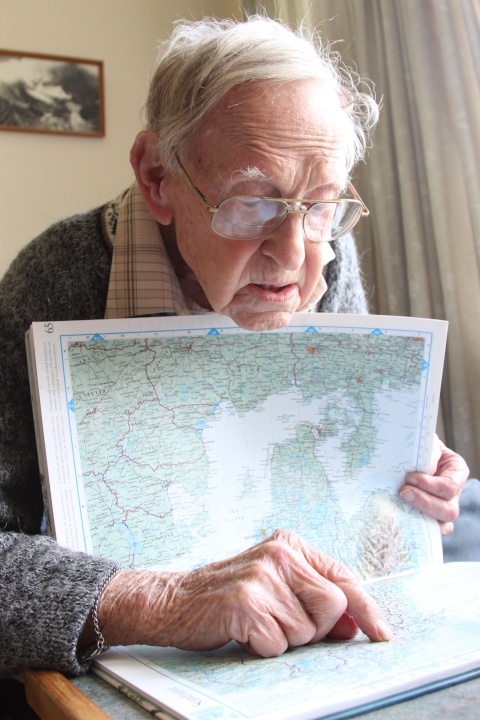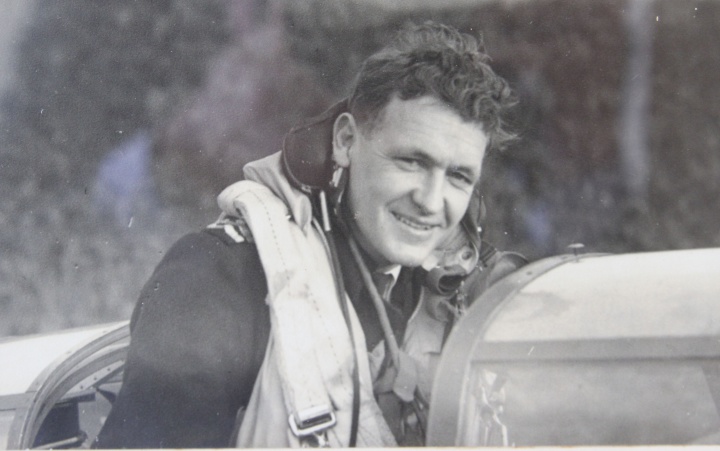Tauranga 101-Year-Old Kept German Battleship in Check
19 December 2018

Tauranga man Peter Densem, who is now 101, might not have sunk the Tirpitz, but he is proud of his four bombing missions that helped contain the German battleship in Norway.
As a young Royal Navy Lieutenant in the Fleet Air Arm, Mr Densem was an observer and navigator in a three-man crew flying Fairey Barracudas from aircraft carriers in the North Sea and Arctic Ocean.
Born in Tauranga, and residing there today, Mr Densem was a sole-charge teacher in a small country school near Gisborne when he joined up at age 23. He applied for the Royal Air Force and was posted in early 1941, travelling to England by ship.
On arrival the airmen were asked if they would transfer to the Fleet Air Arm. By now Mr Densem was thoroughly familiar with boats, and the transfer would still involve flying, so he agreed.

He survived a training crash when his plane went down in a forest at training establishment HMS Goshawk in Trinidad, killing the gunner, and an early group photo shows him with a bent leg, still healing after surgery.
His first sea posting was on the newly commissioned fleet carrier HMS Indefatigable in June 1944, where he learned his trade the hard way in the North Sea. The freezing temperature meant the spray from waves turned to ice, and they were constantly clearing ice off the planes when they were on deck, because the planes had no heating.
“No room for it – we just had clothes,” he said.
As an observer as well as navigator he was essentially in charge of getting the plane back to base.
“Navigation can’t be checked by villages and mountains because you’re over the sea and every wave looks the same,” he said. “You’re leaving a moving base, and you have to get back to that moving base, so your navigation had to be spot on.”
The crew would hunt for enemy ships and submarines, as the fleet carrier escorted convoys to Murmansk in Russia. If they spotted one, they would “cross the T”, flying at right angles to the vessel.
“You’d check its course, look at the wake, and try to guess its speed. When your warship arrived and started firing, you would help the spotter to correct the gunner’s fire. And while all that’s happening you’ve got to think of your navigation, and how much time you’ve got left to fly.”
His crew dive-bombed German battleship Tirpitz, which was sheltering near a mountain in a Norwegian fjord, trying to make repairs. The Germans would put up smoke screens and defend the ship vigorously when the planes attacked.
“She was a whopping big ship, but very hard for us to get to. We’d fly in very low over the sea, to stop their radar picking us up. Then we’d have to lift over the mountain, and we’d dive-bomb her.
“They’d have small arms firing at us all the way down, and the flak – you could see it coming at you. You’d think it was moving very slowly then the next thing, it’s going very fast.”
The dive put huge pressure on the aircraft, and the crew, he said.
“You could see the skeleton of the wing showing up with the pressure. Those planes weren’t really built for it.
“The dive affected some people more than others, especially a straight dive. At one stage we were issued with pressure belts, to push your belly up when you were diving, but we didn’t always use them.”
The bombs they carried weren’t big enough to pierce the ship’s deck, he said.
“But we did a good job of holding her in the fjord. If she had got out among the convoys there would have been devastation.”
The bombers had to fly down the fjord to get away, rather than pull up again.
“The ladies would come out of the houses and wave towels at us,” Mr Densem said.
The RAF eventually sank the Tirpitz, with Lancaster bombers dropping 12,000-pound Tallboy bombs.
In early 1945 Mr Densem and his squadron were worked up for duties in the Pacific, with the war nearly over in Europe, but with the dropping of the atomic bombs in Japan the war was effectively over for him.
He has a particularly fond memory of being in London on leave when victory in Europe was announced in May.
“I was at the memorial by Buckingham Palace and there was this big crowd there. I looked beside me and it was Princess Elizabeth, with a couple of detectives.”
Princess Elizabeth and her sister Margaret famously mingled incognito among the crowd that day.
“I said to her, “Why aren’t you with all the others?” She said, “I wanted to see what it was like down here’.”
ends


 University of Auckland: Tributes Flow For Much Loved Pacific Leader Melegalenu’u Ah Sam
University of Auckland: Tributes Flow For Much Loved Pacific Leader Melegalenu’u Ah Sam NZEI: Ministry Of Education Cuts Will Disproportionately Affect Pasifika
NZEI: Ministry Of Education Cuts Will Disproportionately Affect Pasifika Day One Hapai te Haeata: Call To Action For Young Filmmakers Against The Backdrop Of Funding Cuts
Day One Hapai te Haeata: Call To Action For Young Filmmakers Against The Backdrop Of Funding Cuts Toyota New Zealand: Three Races For Top Three To Decide TR86 Title
Toyota New Zealand: Three Races For Top Three To Decide TR86 Title Wellington City Council: Wellington Is All Action Stations For The Faultline Ultra Festival
Wellington City Council: Wellington Is All Action Stations For The Faultline Ultra Festival Melanie Allison: Local Playwright Casts A Spell Over Hamilton
Melanie Allison: Local Playwright Casts A Spell Over Hamilton